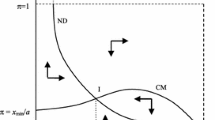Abstract
We study local interaction within a population located on a connected graph. Subjects engage in several bilateral interactions during each round in a generalized Prisoners' Dilemma (PD). In each round of play one randomly selected player gets the possibility to update the action he plays in this PD. All individuals use the update rule “Win Cooperate, Lose Defect,” a multi-player variant of Tit-for-Tat. Theoretical results on the set of stable states of the associated dynamics are provided for the cases with and without rare mutations. Simulations provide insight into the probability distribution over these stable states. In both cases a rather high probability is assigned to stable states with a moderate level of cooperation implying that dominated strategies are used. Furthermore, the probability of reaching the stable state with Nash equilibrium play is small.
Similar content being viewed by others
References
Binmore, K. G., and Samuelson, L. (1992): “Evolutionary Stability in Repeated Games Played by Finite Automata.”Journal of Economic Theory 57: 278–305.
— (1997): “Muddling Through: Noisy Equilibrium Selection.”Journal of Economic Theory 74: 235–265.
Camerer, C. F. (1997: “Progress in Behavioral Game Theory.”Journal of Economic Perspectives 11: 167–188.
Ellison, G. (1993): “Learning, Mucal Interaction, and Coordination.”Econometrica 61: 1047–1071.
— (1995): “Basins of Attraction, Long Run Equilibria, and the Speed of Step-byStep Evolution.” Working Paper 96/4, Department of Economics, Massachusetts Institute of Technology, Cambridge, Mass.
Eshel, I., Samuelson, L., and Shaked, A. (1998): “Altruists, Egoists and Hooligans in a Local Interaction Model.”American Economic Review 88: 157–179.
Eshel, I., Sansone, E., and Shaked, A. (1999): “The Emergence of Kinship Behavior in Structured Populations of Unrelated Individuals.” International Journal of Game Theory 28: 447–463.
Kandori, M., Mailath, G. J., and Rob, R. (1993): “Learning, Mutation and Long Run Equilibria in Games.”Econometrica 61: 29–56.
Karandikar, R., Mookherjee, D., Ray, D., and Vega-Redondo, F. (1998): “Evolving Aspirations and Cooperation.”Journal of Economic Theory 80: 292–331.
Kelley, H. H., and Thibaut, J. W. (1978):Interpersonal Relations: a Theory of Interdependence. New York: Wiley.
van der Laan, G., and Tieman, A. F. (1998): “Evolutionary Game Theory and the Modelling of Economic Behavior.”De Economist 146: 59–89.
van Lange, P. A. M. (1997): “Perssonsverschillen in Coöperatie, Individualisme en Competitie.”Nederlands Tijdschrift voor de Psychologie 52: 101–110 (in Dutch).
van Lange, P. A. M, de Bruin, E. M. N., Otten, W., and Joireman, J. A. (1997): “Development of Prosocial, Individualistic, and Competitive Orientations: Theory and Preliminary Evidence.”Journal of Personality and Social Psychology 73: 733–746.
Ledyard, J. O. (1995): “Public Goods: a Survey of Experimental Research.” InThe Handbook of Experimental Economics, edited by J. H. Kagel and A. E. Roth. Princeton, N.J.: Princeton University Press.
Messick, D. M., and Liebrand, W. B. G. (1995): “Individual Heuristics and the Dynamics of Cooperation in Large Groups.”Psychological Review 102: 131–145.
Molander, P. (1992): “The Prevalence of Free Riding.”Journal of Conflict Resolution 36: 756–771.
Offerman, T., Sonnemans, J., and Schram, A. (1996): “Value Orientations, Expectations, and Voluntary Contributions in Public Goods.”Economic Journal 106: 817–845.
Palomino, F., and Vega-Redondo, F. (1999): “Convergence of Aspirations and (Partial) Cooperation in the Prisoner's Dilemma.” International Journal of Game Theory 28: 465–488.
Rabin, M. (1993): “Incorporating Fairness into Game Theory and Economics.”American Economic Review 83: 1281–1302.
Samuelson, L. (1997):Evolutionary Games and Equilibrium Selection. Cambridge, Mass.: MIT Press.
Schlag, K. H. (1998): “Why Imitate and if so, how? A Boundedly Rational Approach to Multi-Armed Bandits.” Journal of Economic Theory 78: 130–156.
Selten, R. (1991): “Eolution, Learning, and Economic Behavior.”Games and Economic Behavior 3: 3–24.
Sonnemans, J., Schram, A., and Offerman, T. (1999): “Strategic Behavior in Public Good Games: When Partners Drift Apart.”Economics Letters 62: 35–41.
Thibaut, J. W., and Kelley, H. H. (1959):The Social Psychology of Groups. New York: Wiley.
Topkis, D. M. (1979): “Equilibrium Points in Nonzero-Sumn-Person Submodular Games.”Siam Journal of Control and Optimization 17: 773–787.
Young, H. P. (1993): “The Evolution of Conventions”.Econometrica 61: 57–84.
— (1998):Individual Strategy and Social Structure: an Evolutionary of Institutions. Princeton, N.J.: Princeton University Press.
Author information
Authors and Affiliations
Rights and permissions
About this article
Cite this article
Tieman, A.F., Houba, H. & van der Laan, G. On the level of cooperative behavior in a local-interaction model. Zeitschr. f. Nationalökonomie 71, 1–30 (2000). https://doi.org/10.1007/BF01227494
Received:
Revised:
Issue Date:
DOI: https://doi.org/10.1007/BF01227494




